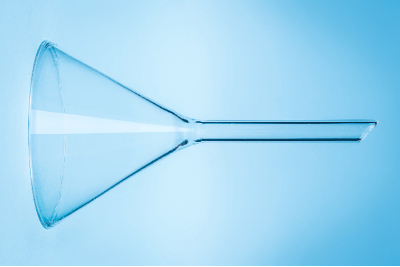What Is a Funnel?

A funnel is a device used to transfer liquid from one container to another.
It is mainly used in chemical experiments. The most common and familiar example is a glass funnel. Its shape is an inverted triangle with a wide opening at the top and a narrower opening at the bottom. At the bottom end is a thin tube.
Uses of Funnels
Funnels are used in two main ways: First, they are used to move liquids. Pouring a liquid directly from one container to another may cause spillage. This is fine for water or other liquids, but for hazardous liquids, a problem arises.
The second use is to separate liquids and solids in suspension. The funnels are lined with filter paper, and liquid with solids dispersed in it is poured through the filter paper and down the narrow tube of the funnels. Meanwhile, the solids remain on the filter paper and can be separated from the liquid.
Principle of Funnels
The principle of funnels depends on the type of funnel. Typical funnel principles are as follows:
1. Separation of Solid and Liquid Using a Glass Funnels
To separate solids and liquids using a glass funnel, filter paper is first placed in an inverted triangular funnel made of glass. By pouring a suspension of solids through the opening of the funnel, the insoluble material is obtained as a residue on the filter paper, while the liquid passes through the filter paper and is separated as a filtrate.
Solid-liquid separation with glass funnels is the simplest example of funnels used for separating solids and liquids, and many of you have used it in elementary school science experiments.
2. Separation of Two Liquids Using Separating Funnels
To separate two liquids using separating funnels, first pour a mixture of two unmixed liquids into the eggplant-shaped container of the separating funnels and allow it to stand still. The upper layer contains a solution of low specific gravity (e.g., oil) and the lower layer contains a solution of high specific gravity (e.g., water), which are clearly separated as two liquids.
The two liquids can be separated by opening the bottom cock and removing only the lower layer.
3. Separation of Solids and Liquids Using Buchner Funnels
At the opening of the Buchner funnel, a circular filtration plate with numerous pores is installed. A filter paper is placed in the circular section, and a suspension of dispersed solids is poured through the opening of the Buchner funnel.
In many cases, the suspension to be poured is one that is difficult to separate from the solid and solution in a normal glass funnel due to its high viscosity or other reasons. For this reason, Buchner funnels are installed in a special device called a suction filtration bottle, and the separation operation is performed by pulling off the solvent by suction with an aspirator.
Filtration using an aspirator is called suction filtration or decompression filtration. Its advantage is that the filtration operation is completed in a shorter time compared to natural flow.
Types of Funnels
There are various types of separation funnels used in chemical experiments, depending on the application. Three types of funnels in particular are often used: glass funnels, separating funnels, and Buchner funnels.
1. Glass Funnels
Glass funnels are used to separate solid and liquid components in a suspension. Glass is the most common material for this type of funnels because of its resistance to organic solvents, which are often used in chemical experiments. A filter paper is laid over the inverted triangular opening.
2. Liquid Separating Funnels
Separating funnels are used to separate two unmixed liquids.
A cock is attached to the glass tube to allow the liquid to flow down, and by opening the cock, the liquid can be passed through and taken out.
3. Buchner Funnels
The Buchner funnels are used to quickly filter suspensions containing large amounts of solids or suspensions with high viscosity. It is made of porcelain, which is resistant to organic solvents and is used by setting it in a suction filtration bottle. In synthetic organic chemistry experiments, Buchner funnels are often used to separate large amounts of crystals from the solvent in a short time.
Other Information on Funnels
Funnel Materials and Precautions for Use
Funnel materials vary widely, including plastic, stainless steel, and glass, and should be selected according to the chemical properties of the liquid to be dispensed.
For example, in many chemical experiments, organic solvents are used that are highly reactive with plastics, so glass funnels with excellent resistance to organic solvents are used.